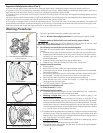
4
• Follow the guidelines below for preparing the wash load.
• Read the Washer Operating Instructions for operating your specific model.
• Always read and follow fabric care and laundry product labels.
To reduce the risk of fire, electrical shock, or injury to persons, read
Important Safety Instructions before operating this washer.
1. Sort laundry into loads that can be washed together.
Sort items by recommended water temperatures, wash time, and agitate/spin
speeds.
• Separate white, light, and colorfast items from dark and noncolorfast items.
• Separate items which shed lint from items which attract lint. Permanent press,
synthetic, knit and corduroy items will pick up lint from towels, rugs and
chenille bedspreads.
• Separate heavily soiled items from lightly soiled items.
• Separate lacy, sheer and loosely knit items from sturdy items.
2. Prepare items for washing.
• Empty pockets.
• Brush off lint and dirt. Shake out rugs and beach towels.
• Close zippers, fasten hooks, tie strings and sashes, and remove nonwashable
trims and ornaments.
• Remove pins, decorative buttons, belt buckles, and other objects which could
be damaged. This also helps protect other items in the wash load.
• Mend rips and tears to prevent further damage during washing.
• Place delicate items such as bras and hosiery in a mesh bag to prevent
tangling during the wash cycle.
• Turn knit items inside out to prevent pilling.
3. Pretreat stains and heavy soil.
See Stain Removal for details.
4. Add laundry load to washer.
• Combine large and small items in a load. Load large items first. Large items
should not be more than half the total wash load.
•
Washing a single item, such as a sweater, bath towel or jeans, is not
recommended. As the machine tumbles the load prior to final spin, it may
sense an out-of-balance load. If an out-of-balance load is sensed, the washer
will stop briefly and tumble for a short time to try to balance the load. This stop-
tumble action may occur several times before the end of the cycle. If the load
can not be evenly balanced, items may feel wet at the end of the cycle. Adding
1 or 2 similar items will help balance the load.
• If a load becomes tangled and out-of-balance, it may be necessary to rearrange
the load by hand. Stop the washer by pushing in the cycle selector knob and
open the door. Remove the load, untangle the items and return the load to the
tub. Close the door and restart washer.
•
A single bulky item, such as a bedspread, comforter or sleeping bag, can be
laundered without adding extra items to the load.
• The washer can be fully loaded, but the items should not be tightly packed.
The door should close easily.
Place delicate items in a mesh bag.
Empty pockets.
Sort laundry into loads that can be
washed together.
Add laundry load to washer.
Washing Procedures
• Do not use any type of spray cleanser when cleaning dryer interior. Hazardous fumes or electrical shock could occur.
• To prevent injury, do not reach into the washer while parts are moving. Before loading, unloading or adding items, push in the
cycle selector knob and allow the tub to coast to a complete stop before reaching inside.
• To prevent injury, do not reach into the dryer if the drum is moving. Wait until the dryer has stopped completely before reaching
into the drum.
• A thermal limiter switch automatically turns off the dryer motor in the unlikely event of an overheated situation (electric dryers only).
A service technician must replace the thermal limiter switch after correcting the fault.
• The washer is equipped with an electrical overload protector. The motor will stop if it becomes overheated. The washer will
automatically restart after a cool down period of up to 30 minutes, if the washer has not been manually turned off during this time.
• Failure to comply with these warnings could result in serious personal injuries.
Important Safety Instructions (Con't)


















